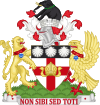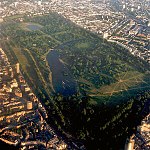geo.wikisort.org - Mountains
Primrose Hill is a Grade II listed public park located north of Regent's Park in London, England, first opened to the public in 1842.[3][6][7] It was named after the 64 metres (210 ft)[lower-alpha 1][8][9] natural hill in the centre of the park, the second highest natural point in the London Borough of Camden.[10] The hill summit has a clear view of central London, as well as Hampstead and Belsize Park to the north and is adorned by an engraved quotation from William Blake. Based on the popularity of the park, the surrounding district and electoral ward were named Primrose Hill.[11]
| Primrose Hill | |
|---|---|
 The view of London from the top of Primrose Hill | |
 The location of Primrose Hill in London | |
| Type | Public Park |
| Location | London Borough of Camden, London, UK |
| Nearest city | London |
| OS grid | TQ282838 |
| Coordinates | 51.5396°N 0.1608°W |
| Area | 25.18 hectares (62.2 acres)[1] |
| Elevation | 64 metres (210 ft)[2] |
| Designated | 1842[3] |
| Operated by | The Royal Parks[4] |
| Status | Open |
| Public transit access | Swiss Cottage tube station, Chalk Farm tube station |
| Part of | Regent's Park |
| Facilities | Playground and toilets[5] |
| Website | www.royalparks.co.uk |
Amenities of the park include an outdoor gym known as the Hill Trim Trail, a children's playground, and toilets, all located on the south side near Primrose Hill bridge which connects to London Zoo and Regent's Park.
History

Like the Regent's Park, Primrose Hill was once part of a great chase appropriated by Henry VIII. Later, in 1841, it became Crown property and in 1842 an Act of Parliament secured the land as public open space. The name "Primrose Hill" has been in use since the 15th century, giving the lie to later claims that it was named after Archibald Primrose, whose premiership witnessed the rapid expansion of London underground rail network London.[12]
In October 1678, Primrose Hill was the scene of the mysterious murder of Sir Edmund Berry Godfrey. In 1679 three Catholic labourers, Robert Green, Henry Berry and Lawrence Hill were found guilty of the murder (though subsequently exonerated) and hanged at the top of the hill. For a few years after the hanging, Primrose Hill was known as Greenberry Hill.[13][14] In 1792 the radical Unitarian poet and antiquarian Iolo Morganwg (Edward Williams) founded the Gorsedd, a community of Welsh bards, at a ceremony on 21 June at Primrose Hill.
The canal through the area was completed in 1816, and the railway, running under the hill, was completed in 1838; this was the first rail tunnel in London. By that time, the area was considered to be a "prime development opportunity" according to one source. In 1840, Charles FitzRoy, 3rd Baron Southampton, sold the land that he owned and new villas were built over the subsequent years. Other land was still owned by Eton College but transferred to the government in 1841. The Crown drained and leveled the land after 1851 and began adding park features, to turn it into "park for the people". The park was historically split between the ancient parishes (which later became metropolitan boroughs) of Marylebone (now part of the City of Westminster), St Pancras and Hampstead (in the modern London Borough of Camden), with the hill itself a part of Hampstead.
As of 2020[update], the Primrose Hill Open Space is managed by The Royal Parks.[15][16]
COVID-19 pandemic

Crowds flocked to Primrose Hill following the loosening of lockdown restrictions due to the COVID-19 pandemic in London. Large amounts of litter were left around the park and social distancing was not observed.[17] This resulted in the closure of Primrose Hill temporarily over the weekend.[18][19]
District

Primrose Hill is a district in the London Borough of Camden, England. Electorally, it is mainly within the Camden Town with Primrose Hill ward, though some other wards do overlap.
The area east of the park was developed and became known as Primrose Hill, after the park. The Primrose Hill district is surrounded by St John's Wood to the west, Swiss Cottage to the northwest, Belsize Park to the north, Chalk Farm to the northeast, Camden Town to the east and Regent's Park itself lies adjacent to the south of the hill itself. The nearest stations to Primrose Hill are Chalk Farm tube station to the northeast and Swiss Cottage tube station to the northwest. The defunct Primrose Hill railway station, now housing a business, sits on the railway lines that separate the Primrose Hill area from Camden Town. Primrose Hill Tunnel, the first railway tunnel in London, has had its eastern portals Grade II*- and its western portals Grade II* listed since 1974.[20][21]
Primrose Hill is an archetypal example of a successful London urban village, due to the location and the quality of its socio-historical development,[22] and is home to many prominent residents. Beginning in the late 1960s several of the roads were closed to motor traffic in response to an unacceptable level of collisions and consequent loss of life. The changes were carefully designed to render the area largely free of through motor traffic.[23]Notable buildings and residents
There are seven English Heritage blue plaques in Primrose Hill commemorating the historic personalities that have lived there.[24] The plaques mark the residences of poet Sir Hugh Clough, historian and broadcaster A. J. P. Taylor and painter William Roberts at 11, 13, and 14 St Mark's Crescent respectively; revolutionary socialist and philosopher Friedrich Engels at 122 (and later 41) Regent's Park Road; photographer Roger Fenton at 2 Albert Terrace; poet and novelist Sylvia Plath at 3 Chalcot Square; and poet William Butler Yeats at 23 Fitzroy Road.[lower-alpha 2][24]
Stanley Johnson and Lukas Heller each lived at different times at the 'Rocking Horse House' on Regent's Park Road. [26] Broadcasters Joan Bakewell and Nicholas Crane and actors Daisy Ridley[citation needed] and Derek Jacobi live in the area.[27][28][29]
Elliott Square is a grouping of modernist 1960s houses by Douglas Streeter, built as part of the Chalcot Estate on land owned by Eton College. [30]
During the 1990s Primrose Hill was a popular place to live with some who worked in the film, music and fashion industries and who were referred to as the Primrose Hill set in British newspapers.[31]See also
- Primrose Hill railway station, by North London Railway
Notes
- Height according to the Ordnance Survey.
- Sylvia Plath also lived at 23 Fitzroy Road, from December 1962 and died there, by suicide, on 11 February 1963.[25]
References
- ESRI Satellite Imagery (Map).
- "Primrose Hill". OpenTopoMap. Retrieved 2 April 2020.
- "Primrose Hill (also known as Primrose Hill Open Space)". Parks and Gardens. Retrieved 5 April 2020.
became a public park in 1842
- "Hold an event in a park". London Borough of Camden. Retrieved 5 April 2020.
Primrose Hill or Regents Park - call Royal Parks
- "Playground". OpenStreetMap. Retrieved 5 April 2020.
- Historic England, "Primrose Hill (1001526)", National Heritage List for England, retrieved 18 June 2017
- Mills, A., Dictionary of London Place Names, (2001)
- "Primrose Hill, Ordnance Survey". Bing Maps. Retrieved 5 April 2020.
- "Primrose Hill heritage grade sheet" (PDF). Historic England. Retrieved 5 April 2020.
- "London Borough Tops". Hill Bagging. Retrieved 5 April 2020.
- "Health & Wellbeing Ward Profile 2013 - Camden Town with Primrose Hill". data.gov.uk. Retrieved 5 April 2020.
- "London Rubble: How The City's Soil Gets Recycled". Londonist. Retrieved 11 June 2017.
- "'Sir Edmund Berry Godfrey's Murder Made Visible', contemporary pamphlet, 1678". PBS LearningMedia. Archived from the original on 4 February 2016. Retrieved 26 January 2016.
- Kenyon, J.P. (2000). The Popish Plot. Phoenix Press reissue.
- "Living on Primrose Hill: Chocolate-box streets, village spirit and some of the best views in London". Country Life. 4 November 2020. Retrieved 4 November 2020.
- "Primrose Hill (also known as Primrose Hill Open Space)". Parks and Gardens. 1 December 2019. Retrieved 4 November 2020.
- "Covid: 'Don't blow it' says health secretary as thousands gather in sunshine". BBC News. 31 March 2021. Retrieved 22 April 2021.
- "Police to close Primrose Hill overnight this weekend". Camden New Journal. Retrieved 22 April 2021.
- "COVID-19: Parks forced to close as sunseekers brawl and leave behind piles of rubbish in 'appalling scenes'". Sky News. Retrieved 22 April 2021.
- "PRIMROSE HILL TUNNELS (EASTERN PORTALS)". Historic England. 14 May 1974. Retrieved 4 November 2020.
List Entry Number:1329904
- "PRIMROSE HILL TUNNELS (WESTERN ENTRANCE)". Historic England. 14 May 1974. Retrieved 4 November 2020.
List Entry Number:1246989
- Barr, Alistair (22 July 2007). "Primrose Hill, An Urban Village Examined" (PDF). Barr Gazetas. Archived from the original (PDF) on 20 April 2016. Retrieved 21 November 2020.
- Camden Cycling Campaign (2014). "Primrose Hill Example" (PDF).
{{cite web}}: CS1 maint: url-status (link) - "Blue Plaques". English Heritage. Retrieved 9 April 2020.
- "Sylvia Plath | Blue Plaques". English Heritage. Retrieved 24 July 2022.
- Ivey, Prudence. "Property Local landmark: former Johnson family home, the legendary 'Rocking Horse House' in Primrose Hill, for sale for £11.25m". Evening Standard.
- McGibbon, Rob (24 March 2019). "A Life in the Day: Labour peer Joan Bakewell on Pilates aged 85". The Times. Archived from the original on 8 April 2020. Retrieved 8 April 2020.
She lives alone in Primrose Hill, north London
- "Primrose Hill People: Nick Crane -". May 2017.
- Farndale, Nigel (2 July 2012). "Derek Jacobi: 'I don't mind people having faith. But it ain't for me'". The Telegraph. Archived from the original on 8 April 2020. Retrieved 8 April 2020.
- "For Sale: Elliot Square, London NW3". The Modern House. Archived from the original on 28 April 2019.
- Craik, Laura (1 June 2015). "Primrose Hill: the NW1 set has lost its cool". Evening Standard. Archived from the original on 8 April 2019.
External links
- Primrose Hill – An Urban Village Examined, [dead link] by Alistair Barr, Architect & Resident — Archived 2007-07-22 at the Wayback Machine
- Article on Primrose Hill Farmers' markets
- Primrose Hill Local Website — Archived 2019-09-13 at the Wayback Machine
- Primrose Hill and Regent's Park in Literature and Music, a bibliography
Другой контент может иметь иную лицензию. Перед использованием материалов сайта WikiSort.org внимательно изучите правила лицензирования конкретных элементов наполнения сайта.
WikiSort.org - проект по пересортировке и дополнению контента Википедии


